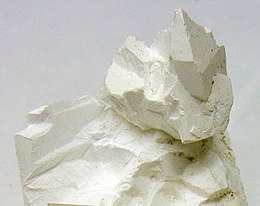
Back Arcanita Catalan Arcanit German Arcanita EU Arcanite French Arcanite Italian Arkanit SL ஆர்கேனைட்டு Tamil Арканіт Ukrainian
| Arcanite | |
|---|---|
 Arcanite | |
| General | |
| Category | Sulfate mineral |
| Formula (repeating unit) | K2SO4 |
| IMA symbol | Acn[1] |
| Strunz classification | 7.AD.05 |
| Crystal system | Orthorhombic |
| Crystal class | Dipyramidal (mmm) H-M symbol: (2/m 2/m 2/m) |
| Space group | Pmcn |
| Unit cell | a = 5.77, b = 10.07 c = 7.48 [Å]; Z = 4 |
| Identification | |
| Color | White to colorless, yellow |
| Crystal habit | Tabular crystals, typically in crusts and coatings |
| Twinning | Cyclic on {110} |
| Cleavage | Good on {010} and {001} |
| Mohs scale hardness | 2 |
| Luster | Vitreous |
| Streak | White |
| Diaphaneity | Transparent to translucent |
| Specific gravity | 2.66 |
| Optical properties | Biaxial (+) |
| Refractive index | nα = 1.494 nβ = 1.495 nγ = 1.497 |
| Birefringence | δ = 0.004 |
| 2V angle | Measured: 67° |
| References | [2][3][4] |
Arcanite is a potassium sulfate mineral with formula K2SO4.
Arcanite was first described in 1845 for an occurrence in old pine railroad ties in the Santa Ana tin mine, Trabuco Canyon, Santa Ana Mountains, Orange County, California, US.[2][4] It has also been reported from hydrothermal deposits in the Cesano geothermal field, Latium, Italy; in bat guano on the Chincha Islands of Peru; and in caves in Western Australia, South Africa and Namibia.[4]
Well-crystalline specimens sold as 'arcanite' are grown synthetically in places such as Poland for the decorative specimen market and are not natural minerals.[2]
- ^ Warr, L.N. (2021). "IMA–CNMNC approved mineral symbols". Mineralogical Magazine. 85 (3): 291–320. Bibcode:2021MinM...85..291W. doi:10.1180/mgm.2021.43. S2CID 235729616.
- ^ a b c Mindat.org
- ^ Webmineral data
- ^ a b c Handbook of Mineralogy